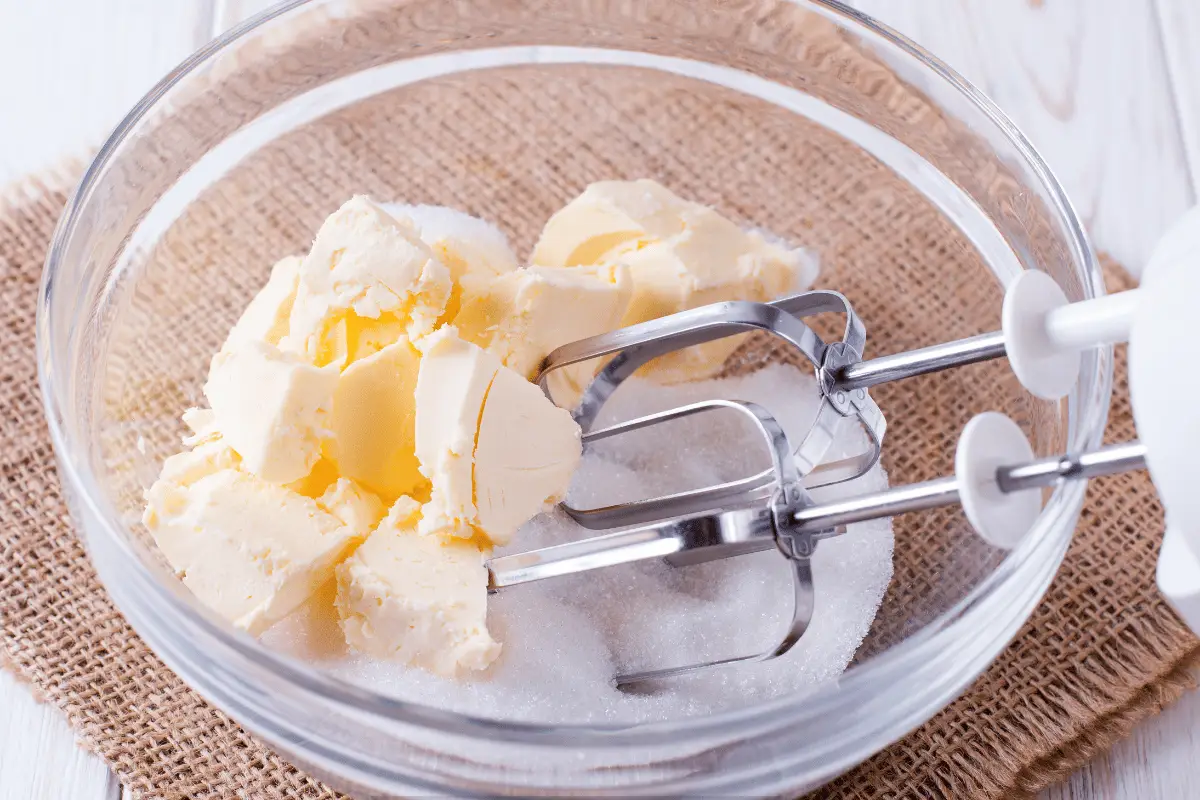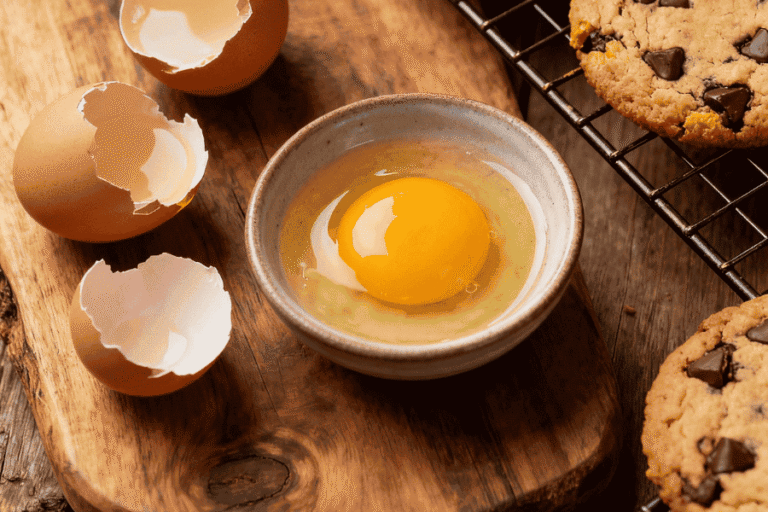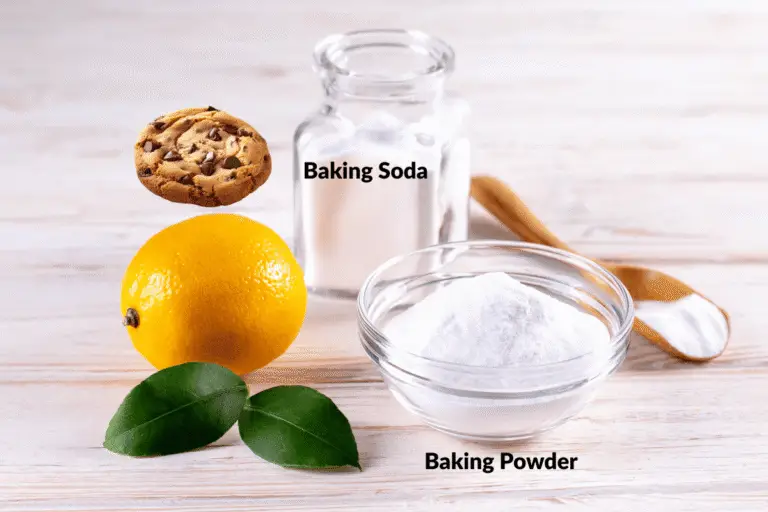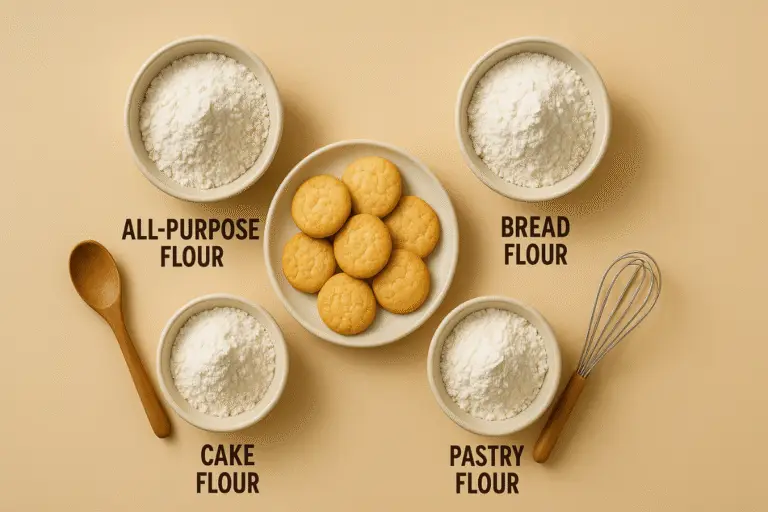What Does Butter Do in Cookies? (Pro Baker’s Guide)

When it comes to baking cookies, butter is more than just a flavor booster — it’s one of the most influential ingredients in shaping how your cookies look, taste, and feel. What does butter do in cookies? Quite a lot. From controlling spread to creating that irresistible chewy or crisp bite, butter plays a central role in cookie science.
With over 17 years of experience in the cookie industry, I’ve seen firsthand how small changes in butter type, temperature, and ratio can completely transform a batch. Understanding how butter behaves in your dough isn’t just for professional bakers — it’s the secret to consistently achieving perfect homemade cookies.
In this guide, we’ll break down the science of butter in cookies, explore the differences between melted, softened, and cold butter, and share pro tips you can apply right away to elevate your baking.
🧈 What Does Butter Do in Cookies?
Butter is one of the most powerful ingredients in cookie baking — it doesn’t just add richness, it transforms the entire structure. So, what does butter do in cookies?
- Adds Flavor: Butter brings a rich, creamy taste that balances sweetness and enhances vanilla, chocolate, and spices.
- Control Texture: The fat content determines whether cookies turn out chewy or crisp. Higher butter ratios often mean softer, chewier cookies.
- Creates Spread: As butter melts in the oven, it helps cookies spread, creating those thin, golden edges many bakers love.
- Improves Mouthfeel: The fat gives cookies a tender, melt-in-your-mouth bite instead of being dry or crumbly.
📌 Quick takeaway: Butter isn’t just a background ingredient — it’s the backbone of cookie flavor, texture, and structure.
👉 Related: What Does Brown Sugar Do in Cookies?
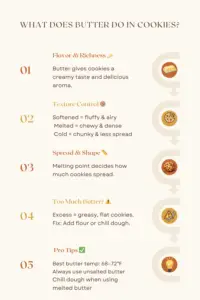
🧑🍳 How Butter Affects Cookie Texture and Spread
Butter plays a science-backed role in shaping your cookies. If you’ve ever wondered how does butter affect cookies, here’s the breakdown:
- Tenderizes the Dough: Butter’s fat coats flour and sugar particles, preventing too much gluten from forming. The result? A tender, soft bite instead of a tough texture.
- Controls Spread: Butter’s melting point determines how much cookies spread in the oven. Warm or melted butter = more spread. Cold or softened butter = less spread and thicker cookies.
- Creates Balance: The right ratio gives cookies crisp edges with chewy centers. Too little butter leads to dry results, while too much makes them greasy and flat.
💡 Industry Insight: In professional baking, we always test multiple butter levels before finalizing a recipe. A balanced quantity ensures cookies hold their shape, while still delivering the ideal flavor and texture.
👉 Related: Why Do Cookies Burn on the Bottom?
🧈 Butter Amount vs Cookie Result
| Butter Amount | Effect on Cookies | Texture & Spread |
| Too Little Butter | Dough feels dry | Cookies are dense, less spread |
| Balanced Butter | Perfect dough consistency | Chewy center + crisp edges |
| Too Much Butter | Dough feels greasy | Cookies spread too much, thin & fragile |
| Melted Butter | Starts spreading quickly | Cookies spread more, softer centers |
| Cold/Softened Butter | Holds shape better | Thicker cookies with less spread |
👉 Related: Why Are My Cookies Too Soft?
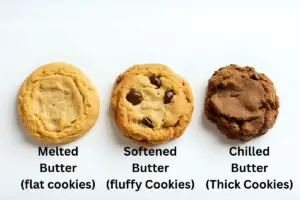
🥄 Melted vs Softened vs Cold Butter in Cookies
Butter temperature plays a huge role in cookie outcomes. Each type creates a different texture, spread, and overall bite.
- Melted Butter → Produces cookies that are chewy, dense, and spread more. Great for soft-baked styles.
- Softened Butter → Incorporates air when creamed with sugar, giving cookies a fluffy, airy texture with moderate spread.
- Cold Butter → Limits spread, resulting in chunkier, thicker cookies — ideal for rustic chocolate chip cookies.
💡 Industry Insight: In professional cookie production, we almost always use room temperature butter (26–28°C) to achieve consistent results and proper aeration.
📊 Tip: If you want both chew and lift, try mixing half melted butter with half softened butter — a trick used by many bakers.
👉 Related: Why Is My Cookie Dough Too Sticky or Wet?
Want to quickly see how butter temperature affects cookies? Try this interactive box:
🍪 What Does Butter Do in Cookies?
⚠️ What Happens If You Use Too Much Butter in Cookies?
Adding more butter than the recipe calls for might seem harmless, but it can completely change your cookies:
- Excess Spread – Cookies flatten out too much and lose their shape.
- Greasy Texture – The surface feels oily instead of pleasantly soft.
- Fragile Structure – Cookies may break apart easily instead of holding a chewy or crisp bite.
✅ How to Fix Cookies With Too Much Butter
- Add Flour → A spoonful or two of flour helps absorb extra fat.
- Chill the dough → Cooling solidifies butter, preventing excessive spreading in the oven.
💡 Industry Insight: In professional baking, butter is always measured precisely in kilograms to avoid inconsistencies. Getting the ratio right is the secret to perfect cookie texture every single time.
👉 Related: Why Do My Cookies Spread too Much?

💡 Pro Baker Tips for Using Butter in Cookies
Butter may seem simple, but small details in how you use it can make a big difference in your cookies. Here are some expert tips:
- Butter Temperature Matters (68–72°F / 20–22°C): This is the sweet spot for creaming butter with sugar. Too cold, and it won’t cream properly; too warm, and it melts instead of aerating. (Keyword: butter temperature for cookies)
- Chill Dough When Using Melted Butter: If your recipe calls for melted butter, always chill the dough before baking to prevent over-spreading.
- Adjust Ratios for Desired Texture:
- Higher butter ratio → softer, chewier cookies.
- Lower butter ratio → crisper, snappier cookies.
- Salted vs. Unsalted Butter: Professional bakers almost always use unsalted butter. This gives precise control over the amount of salt in the recipe.
💡 Industry Insight: In the cookie industry, we never rely on salted butter. Instead, we use unsalted butter and measure salt separately to achieve consistent flavor in every batch.
🍪 Chewy vs Crisp Cookies: Butter Ratio Comparison
| Cookie Style | Butter Ratio (to Flour) | Texture Result | Best For |
| Chewy Cookies | Higher butter (1:1.25 or more) | Soft, moist, flexible | Chocolate chip, oatmeal |
| Crisp Cookies | Lower butter (1:2 or less) | Thin, crunchy, snappy | Biscotti, wafer-style |
Pro Tip: Ratios vary slightly depending on sugar and flour type, but butter always plays a key role in balancing spread and texture.

✅ Conclusion
Butter is more than just an ingredient—it’s the foundation of flavor, texture, and spread in every cookie. Now you know exactly what butter does in cookies and how factors like temperature, quantity, and technique shape the final results. Whether you want chewy, crisp, or chunky cookies, mastering the role of butter is the key.
👉 Ready to take your baking to the next level? Explore our other cookie ingredient guides to build your skills and get bakery-quality results at home.
📌 For a deeper dive into the science of butter, check out this resource from King Arthur Baking.
And don’t forget—having the right tools makes baking easier. Discover our recommended cookie tools here.
❓ FAQs:What Does Butter Do in Cookies?
1. What happens if you don't put enough butter in your cookies?
2. What does adding more butter to a cookie recipe do?
3. Are cookies better with butter or oil?
4. What does softened butter do in cookies?
5. What does melted butter do in cookies?
6. What does cold butter do in cookies?

